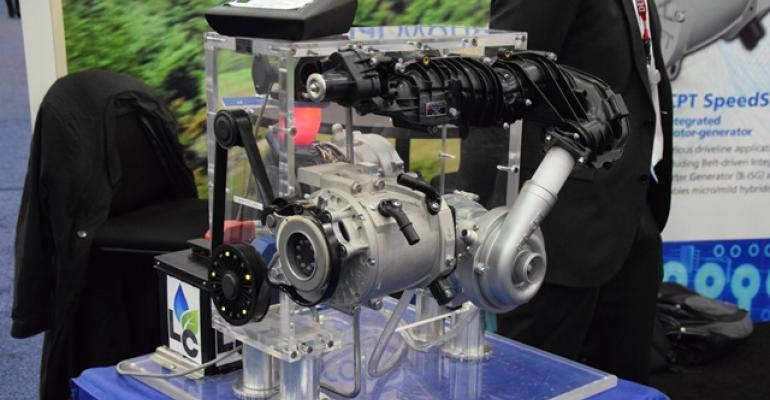DETROIT – The auto industry is on the path toward 48-volt electrical architectures and broader application of electrified internal-combustion powertrains, says U.K.-based CPT Technologies’ top executive, pointing out the trajectory plays nicely with the developer’s latest product strategy.
Spun off from Visteon in 2007, CPT designed and then sold to France’s Valeo an electric supercharger it developed. That technology is expected to appear on an Audi vehicle in 2016, likely the next-generation RS7, with additional installations from other automakers to follow.
In late 2012, Valeo said it had 10 OE application test programs under way for the electric supercharger, predicting as many as three of those projects could result in production programs in the 2015-2016 timeframe.
With the supercharger sale to Valeo marking CPT’s first big business win, the supplier now is turning most of its focus to its advanced stop-start technology, dubbed CPT SpeedStart. It is the second piece of the company’s 3-leg product stool that includes an exhaust-gas energy-recovery system still in the early stages of development.
SpeedStart, based on water-cooled switched-reluctance motor technology, has been in the works for more than a decade and has been showcased in the LC (Low Cost, Consumption, Carbon) Super Hybrid concept vehicle that has served as a test bed for the device since 2012.
The LCSH concept, based on an ’11 Volkswagen Passat with a 1.4L TSI gasoline engine, is backed by a number of suppliers and organizations, including Valeo, Exide Batteries, Mubea, AVL and the Advanced Lead-Acid Battery Consortium.
Initially achieving a fuel-economy gain of 7% with a 12-volt electrical architecture and 13% with a 48-volt bus during testing, CPT now reports that tweaks to the device’s control software over the past year have boosted that 48-volt mileage improvement to 18%.
CPT believes 48 volts is the system’s sweet spot and is the direction automakers are moving as they look to add electrification throughout the driveline, because it provides more power than today’s 12-volt architecture but is a low enough voltage not to require extra safety measures and the high-capacity, expensive batteries necessary with full-hybrid vehicles.
“Forty-eight volts is really the optimum position between efficiency and cost,” CPT CEO Nick Pascoe tells reporters and analysts at a backgrounder here. “And it doesn’t involve ripping up your powertrain.”
With the step-up in voltage to 48, plus the calibration changes made in the past year, the SpeedStart system is able to provide more electrical assistance at strategic points along the typical driving cycle, potentially closing the gap between a vehicle’s stated fuel economy and what buyers tend to achieve in day-to-day driving, Pascoe says.
The shortfall in real-world performance “partially is due to the technology being used and how it can adapt to driving styles,” he says. “We all know we can affect fuel economy by 20% at least, just by how we put our foot on the gas. It’s as simple as that.”
Using electric power, rather than the internal-combustion engine, to get that extra power when the driver punches the accelerator is where the 18% fuel-economy savings is generated.
The supplier’s game plan with SpeedStart is the same it followed with its supercharger: Interest automakers and then sell the technology to a supplier that wants to produce it. CPT is going up against some heavyweight competitors with the system, including Germany’s Bosch, Continental and Hella.
Pascoe doesn’t specify the cost to OEMs of the CPT technology, including the shift to a 48-volt electrical architecture, but hints it could approach $1,000 per car initially, with a longer-range target of whittling that down closer to $300 per unit when economies of scale kick in. The extra cost would include the outlay for a 48V lithium-ion battery to go alongside the existing 12-volt lead-acid unit, a DC-DC converter and additional cabling.
“When you get a bunch of engineers working on a system, they’ll get it better and cheaper,” he says.
CPT also is looking toward an in-vehicle test later this year that would combine SpeedStart with its TIGERS exhaust-gas energy-recovery technology. The company says the combination could improve fuel economy by a double-digit rate, without requiring an electric supercharger to boost performance.
Pascoe says to look for 48-volt electrical architectures to begin to be applied to volume platforms in 2019-2020 and then reach the majority of the market within a decade.
The proliferation of 48-volt systems could pave the way for additional electrification further down the driveline, the executive says.
The same switched-reluctance motor technology employed in CPT’s SpeedStart could be used to create hybrid transmissions, he says, allowing automakers to reverse the trend toward more gears that is seeing 9- and 10-speed automatics emerge, allowing transmission weight and cost to be cut 25%.
“The internal-combustion engine remains the heart of the system, but there will be far more electrical energy flowing around that that is more revolutionary than evolutionary,” Pascoe says of the car of the future. “These simple electrical machines are getting smarter, and that means base engines can get simpler.”





